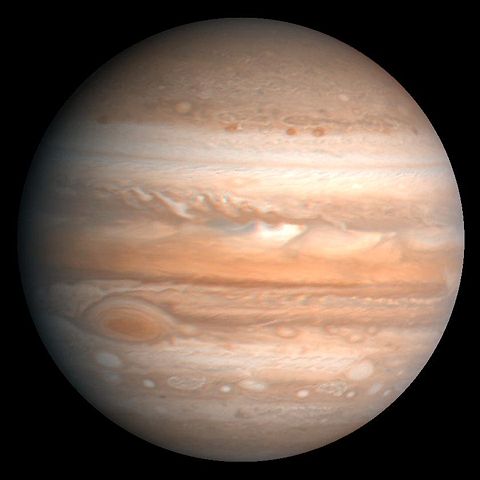 |
This is a file from the Wikimedia Commons. Information from its description page there is shown below.
Commons is a freely licensed media file repository. You can help.
|
 |
This image appeared on Wikipedia's Main Page in the Did you know? column on 2 April 2008. |
|
| Description |
English: Original Caption Released with Image: This processed colour image of Jupiter was produced in 1990 by the U.S. Geological Survey from a Voyager image captured in 1979. The colors have been enhanced to bring out detail. Zones of light-colored, ascending clouds alternate with bands of dark, descending clouds. The clouds travel around the planet in alternating eastward and westward belts at speeds of up to 540 kilometers per hour. Tremendous storms as big as Earthly continents surge around the planet. The Great Red Spot (oval shape toward the lower-left) is an enormous anticyclonic storm that drifts along its belt, eventually circling the entire planet.
Suomi: Käännös alkuperäisestä kuvatekstistä: Tämän jälkikäsitellyn kuvan Jupiterista loi U.S. Geological Survey vuonna 1990 Voyagerin 1979 ottamasta kuvasta. Värejä on muokattu yksityskohtien parantamiseksi. Vaaleat, nousevat pilvivyöhykkeet ovat tummempien, laskeutuvien pilvivyöhykkeiden lomassa. Pilvet liikkuvat itään 540 km:n tuntinopeudella, länteen liikkuvien pilvimassojen nopeudet vaihtelevat. Mannerlaattojen kokoiset myrskyalueet kiertävät planeettaa. Suuri punainen pilkku (soikea kohde vasemmassa alakulmassa) on valtava pyörremyrsky, joka kiertää hitaasti planeetan pinnalla.
Français : Cette photographie de Jupiter a été produite en 1990 par le U.S. Geological Survey à partir d'une photographie prise par une sonde Voyager en 1979. Les couleurs ont été améliorées afin de révéler le plus de détails possibles. Des zones claires de nuages ascendants alternent avec des bandes foncées de nuages descendants. Les nuages parcourent la planète en ceintures alternantes d'est en ouest, et vice-versa, à une vitesse de plus de 540 km/h. D'énormes tempêtes aussi grosses que des continents terrestres surgissent tout autour de la planète. La « grande tache rouge » (forme ovale en bas à gauche) est une énorme tempête anticyclonique qui glisse le long de sa ceinture, tournant perpétuellement autour de la planète.
Gaeilge: Iúpatar, an pláinéad is mó sa Grianchóras
Gaelg: Jupiter, y planaid smoo ayns Corys ny Greiney
|
| Date |
1990 processing of 1979 imagery |
| Source |
http://photojournal.jpl.nasa.gov/catalog/PIA00343
 |
This image or video was catalogued by Jet Propulsion Lab of the United States National Aeronautics and Space Administration (NASA) under Photo ID: PIA00343.
This tag does not indicate the copyright status of the attached work. A normal copyright tag is still required. See Commons:Licensing for more information.
|
|
| Author |
NASA/JPL/USGS |
Permission
( Reusing this file) |
| Public domainPublic domainfalsefalse |
 |
This image is in the public domain because it contains materials that originally came from the United States Geological Survey, an agency of the United States Department of the Interior. For more information, see the official USGS copyright policy.
български | català | Deutsch | English | español | eesti | suomi | français | galego | italiano | 한국어 | македонски | മലയാളം | Nederlands | polski | português | русский | Türkçe | 中文 | 中文(简体) | +/−
|
|
 |
This image, which was originally uploaded with an assertion of Public Domain status, was reviewed on 18 February 2011 by the administrator or trusted user Jappalang ( talk), who confirmed the Public Domain status on that date. |
|
File usage
The following pages on Schools Wikipedia link to this image (list may be incomplete):
Wikipedia for Schools is one of SOS Children's many educational projects. Thanks to SOS Childrens Villages, 62,000 children are enjoying a happy childhood, with a healthy, prosperous future ahead of them. There are many ways to help with SOS Children.




